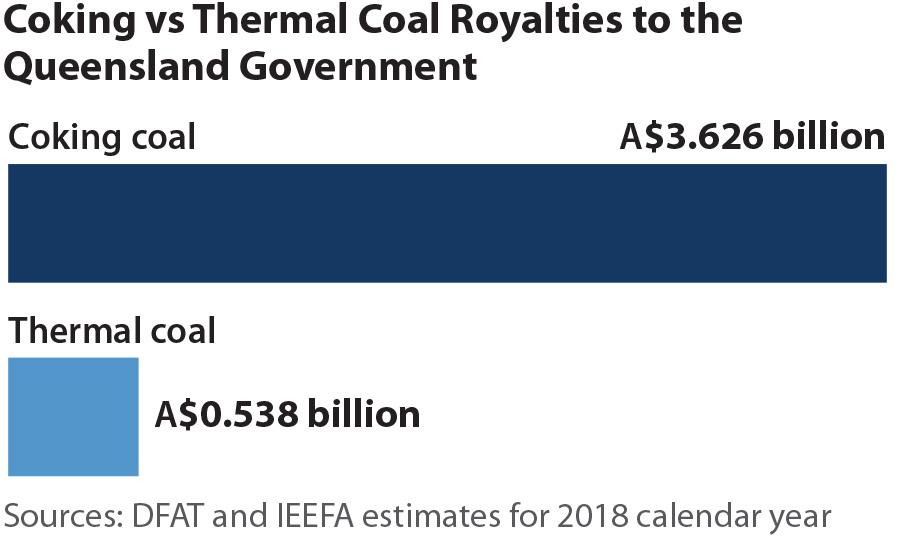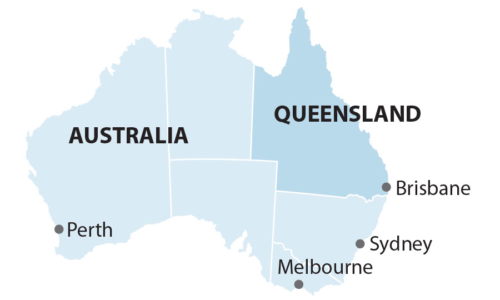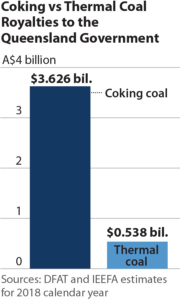IEEFA Australia: Time to differentiate – thermal coal delivers royalty crumbs compared to Queensland’s coking coal

 3 June 2019 (AUSTRALIA): Thermal coal used for electricity provides only 13% of royalties to Queensland’s budget compared to coking coal used for steel manufacturing – which provides 87% in royalties, a new IEEFA report finds.
3 June 2019 (AUSTRALIA): Thermal coal used for electricity provides only 13% of royalties to Queensland’s budget compared to coking coal used for steel manufacturing – which provides 87% in royalties, a new IEEFA report finds.
The report, Conflating Queensland’s Coking and Thermal Coal Industries: Thermal coal adds little to Queensland’s state budget finds that coking coal export royalties contribute seven times more than thermal coal royalties to the Queensland budget, estimated at $3,626m versus just $538m from export thermal coal.
Author Tim Buckley, Director of Energy Finance Studies IEEFA says in comparison, existing and new coking coal mines, like the Olive Downs coking coal mine near Moranbah approved two weeks ago, will boost Queensland’s coffers with an extra $600m annually – more than the total contribution of thermal coal.
 “It’s time to differentiate between structurally challenged thermal coal used for electricity and high value coking coal used in steel manufacturing,” says Mr Buckley.
“It’s time to differentiate between structurally challenged thermal coal used for electricity and high value coking coal used in steel manufacturing,” says Mr Buckley.
“Coking coal and thermal coal supply entirely different industries. They have very different volume trajectories going forward and have drastically different values.
“Today, exported coking coal provides a significant 87% of Queensland’s royalties from coal, with just 13% provided by thermal coal.”
“Coking coal is valued by the market at three times as much per tonne as Queensland’s thermal coal, and boosted by the progressive royalty rates already in place, coking coal pays four times the royalties of thermal coal per tonne.”
IEEFA notes burning coal is still the number one cause of global warming, but renewable alternatives are fast replacing thermal coal, while technologies to replace coking coal are yet to be commercialised.
Coking coal is going to be around for decades yet, while thermal coal, which peaked back in 2014, is being progressively replaced by alternative technologies and is forecast for terminal decline by 2050.
“Simply, coking coal and thermal coal are like chalk and cheese, providing vastly different numbers of jobs, value and royalty returns to the people of Queensland,” says Mr Buckley.
“The Federal Resources Minister Matt Canavan, the Queensland Resources Council, and Adani are deliberately confusing people by combining coking and thermal coal, when they are completely different products offering completely different benefits to Queenslanders.
“The people of Queensland need to know the truth when their government is being pressured to make a decision about approving Adani’s proposed high ash, low energy thermal coal mine for so little return to the State.
“In this carbon constrained world, instead of approving new thermal coal mines, the Queensland government needs to be strategic and manage the transition out of thermal coal.
“This buys time for the state to best leverage the strategic value and economic support of the coking coal sector even as Queensland pivots to 50% renewables by 2030.”
Queensland already has numerous world-leading renewable projects like Genex Power’s 250 megawatt (MW) pumped hydro storage and solar, Sun Metals’ integrated 125MW solar powered zinc refinery, Northern Oil’s Gladstone hydrogen power plant pilot, Ratch’s A$380m 180MW Mount Emerald Wind Farm, and AGL’s 453MW Coopers Gap Wind Farm.
Two weeks ago, the Queensland government approved the Olive Downs 15Mtpa coking coal mine near Moranbah in Queensland’s Bowen Basin, with A$4bn of annual revenues. This mine leverages existing infrastructure and will provide jobs and royalties without any royalty holiday period.
In contrast, the proposed Adani Carmichael mine will dig up low energy, high ash thermal coal at one quarter of the royalties and provide annual revenues of some A$725m, a fifth of that created by Olive Downs.
Delivery on the Paris Agreement objectives requires OECD countries to phase out unabated thermal coal production by 2030.
IEEFA notes regional Queensland’s transition risk is a much more manageable task compared with the predominantly thermal coal industry of New South Wales’ Hunter Valley.
“The Queensland government looks likely to approve a thermal coal mine which might employ 500 people ongoing, and following a decade of zero royalties, will only provide one quarter of the royalties per tonne relative to Queensland’s high value coking mines, and raises Queensland’s exposure to a low value product that is well past its peak and is now in slow, terminal decline,” says Mr Buckley.
“Exploiting the proposed Galilee Basin for thermal coal is a dud bet for Queenslanders.
“Far better to invest in strong, growing industries of the future to the sustainable benefit of regional Queensland.”
Read the report Conflating Queensland’s Coking and Thermal Coal Industries: Thermal coal adds little to Queensland’s state budget
Media Contact: Kate Finlayson ([email protected]) +61 418 254 237
Author Contact: Tim Buckley ([email protected]) and Simon Nicholas ([email protected])
About IEEFA: The Institute for Energy Economics and Financial Analysis (IEEFA) conducts research and analyses on financial and economic issues related to energy and the environment.
Related links:
IEEFA Australia: Government forecasts declining economic contribution from thermal coal
IEEFA Australia: Key thermal coal off-takers continue to abandon coal-fired power projects












